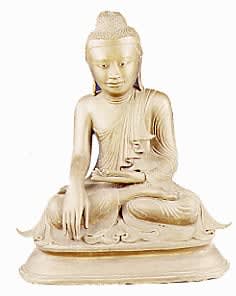Mandalay Bronze Sculpture of the Buddha Seated, 18th Century CE - 19th Century CE
Bronze
14 x 17
PF.2358
The Mandalay Period represents the last great cultural flourishing of Burmese art. The period was named after the city of Mandalay, which served as capital of Myanmar for a brief...
The Mandalay Period represents the last great cultural flourishing of Burmese art. The period was named after the city of Mandalay, which served as capital of Myanmar for a brief period (1860-1885 A.D.) during the reign of King Mindon. After the Anglo-Burmese Wars, northern Myanmar was shut off from the coastal areas that were controlled by the British. King Mindon founded the new capital at a sacred site at the foot of a large hill. The center of the city was designed in the perfect geometrical form of a Buddhist Mandala, giving the city its name. Although this short-lived kingdom finally fell to the British forces in 1886 A.D. during the Third Anglo-Burmese War, the Royal Guilds that created such remarkable works of art for the King remained in the city where they continued to produce sculptures in the Mandalay style.
Posed in the characteristic seated, cross-legged position of meditation, his hands forming a Mudra, (the mystic ritual gesture signifying various powers), this serene bronze Buddha emanates a profound spiritual beauty. Two of the thirty-two superior physical marks that distinguish the Buddha--extended earlobes and a bulge atop the head signifying the Buddha's superior knowledge and consciousness--combine to create a radiant and mystical aura. Artistically inlaid eyes serve to accentuate this divine expression. The sculpted Samghati, (the monastic robe worn by the Buddha and members of the order), drapes gracefully across the Buddha's body, flowing like a series of soft, ethereal waves. To behold this bronze sculpture is to experience an artistic expression that indeed transcends the world of mere mortals.
Posed in the characteristic seated, cross-legged position of meditation, his hands forming a Mudra, (the mystic ritual gesture signifying various powers), this serene bronze Buddha emanates a profound spiritual beauty. Two of the thirty-two superior physical marks that distinguish the Buddha--extended earlobes and a bulge atop the head signifying the Buddha's superior knowledge and consciousness--combine to create a radiant and mystical aura. Artistically inlaid eyes serve to accentuate this divine expression. The sculpted Samghati, (the monastic robe worn by the Buddha and members of the order), drapes gracefully across the Buddha's body, flowing like a series of soft, ethereal waves. To behold this bronze sculpture is to experience an artistic expression that indeed transcends the world of mere mortals.
Literature
V7



